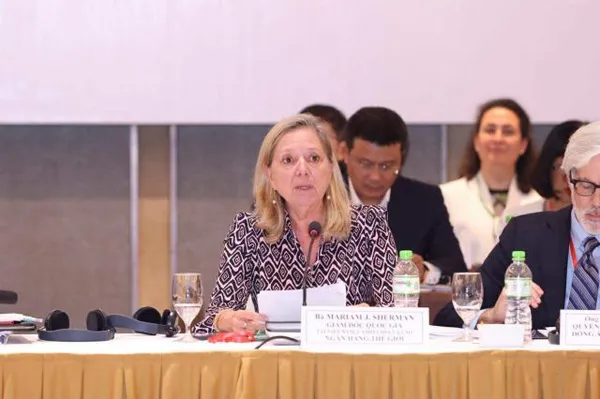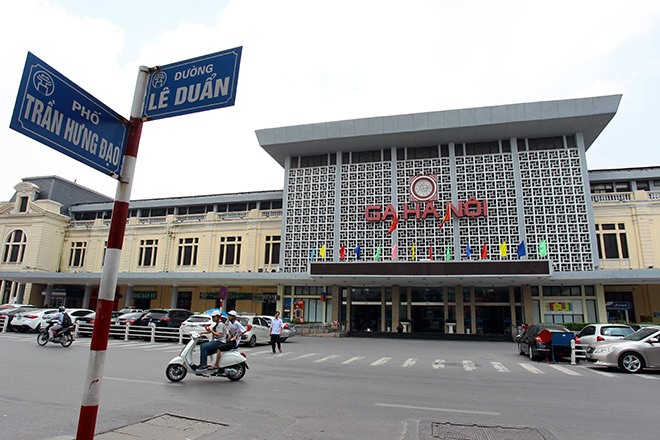 Op-Ed
Op-Ed

For the second time in two years, a proposal put forward by the Hà Nội Police Department to move Hà Nội Railway Station (HNRS) and all inter-provincial railway tracks to the suburbs has been rejected by many experts and citizens.
 |
| Hà Nội Railway Station (HNRS). — Photo 24h.com.vn |
By Mai Khuyên
For the second time in two years, a proposal put forward by the Hà Nội Police Department to move Hà Nội Railway Station (HNRS) and all inter-provincial railway tracks to the suburbs has been rejected by many experts and citizens.
The move, according to Major General Phạm Xuân Bình, deputy-director of the department, would help eliminate traffic congestion at rail and road intersections, ease traffic pressure in the inner city, and reduce accidents.
Opponents to the proposal, including the Railway Corporation and the Ministry of Transport, argue that the HNRS is an important urban transport hub. It is also a hub for transport planning in the city by 2030, which was approved by the prime minister, so it is not possible to move it without significant disruption. Additionally, as the cost of relocation, including alterations and repair of infrastructure, will be enormous, a final decision should be given a lot of consideration.
As a Hanoian who has spent almost all of my life in the capital city and enjoyed the HNRS as the final stop on many of my trips around the country, I too object to the move. Although Bình is attempting to put forward progressive solutions to a severe issue in the city – the congestion, I don’t support this particular idea.
Putting aside my personal attachment to the issue, I’ll turn to a more serious and probably more pressing issue that currently faces the Government, authorities and policy-makers: the management of public assets, particularly the so-called “golden” land in big cities.
Việt Nam is involved in efforts to solve the worsening congestion in big cities by moving many government offices, universities and hospitals from the inner city, to provide more space for residential areas and transportation.
A number of satellite urban areas were built on the outskirts of cities to prepare for such a move.
A master plan for the construction of the capital set an ambition to turn it into a beautiful and modern city by 2030.
But after 10 years of implementation, the plan seems to have gone off the rails. So far, results have been limited, and the process itself has been progressing at a snail’s pace.
While thousands of billions of đồng were pouring into building new headquarters in the satellite cities, many government departments and authorities were still trying to keep using the old land to do business, either by leasing the premises or allowing investors to put up buildings for sale or for rent at exorbitant prices.
How could such a situation happen?
The case of HNRS is only one among many that are part of the above larger picture. The issues raised relate to the increasing dispersal or abuse of public assets. It is a problem that seems to be growing out of control.
The dispersal or abuse of public assets is sophisticated and hard to handle due to loopholes resulting from weak management of authorities.
Although I personally don’t support the proposed move of HNRS, which is currently located on some of the city’s “golden” land, the issue does deserve deliberation.
If the move was going to go ahead, the question would be how best to utilise the vacated land
It is estimated that the total land area occupied by HNRS in central Hà Nội stretches to about 21 hectares, or 210,000 sq.m. Based on the value of surrounding land, it could also be estimated the total cost of the land is no less than US$3 billion.
This is clearly an attractive proposition for real estate investors and developers.
Authorities could insist on using such “golden” land to build a public centre for cultural activities, but no one could be sure that a shopping mall or residential buildings wouldn’t be built and claimed to benefit culture.
A recent report by a local newspaper revealed in the first phase of a Government inspection campaign on suspected projects that were built on “golden” land, among 60
"golden" land lots which had been submitted to the Government for inspection, Hà Nội accounted for nearly 50 per cent of the total.
Most of these "golden" land lots were in prime locations and used to be public assets, but now have become private real estate or housing projects for sale.
The land, which should have been used for the construction of public facilities like parks or cultural centres, has been turned into high-rises with high population densities.
The result is more profit for investors, but surely more traffic chaos and the further degradation of the city’s beauty.
Even worse, among these projects, many have been found to have violated the law on land use causing losses for the State budget.
It is critical that while the equitisation of State-owned enterprises is promising to revitalise the national economy, there is a tendency among individuals or private estate companies to take advantage of this guideline for profit and self-serving purposes. They try to manipulate and acquire as much of the city’s “golden” land as possible. This has caused the loss of property which used to belong to the State.
The manipulation may occur in many other places in the inner city, such as the four bus stations of Gia Lâm, Giáp Bát, Nước Ngầm and Mỹ Đình, which are planned to be removed after 2020. The enormous areas taken up by these four stations, and the vast value they could bring on the real estate market, will ensure they are an "apple of discord" between social benefits and private interests.
The wave of dispersal of state assets and the abuse of public real estate is a side effect of the equitisation process and it is now becoming more obvious.
Along with Government efforts to boost reforms in State-owned sectors, particularly for socio-economic development, the number of equitised SOEs is likely to increase. However, there is a growing risk of losing public assets.
A variety of projects have been built on “golden” land lots in the city including the old State-owned Cát Linh Brick factory, the Trần Hưng Đạo factory at the end of Bà Triệu street, and the old parking lot on Thanh Niên Road.
There may be many more commercial projects developed in the city that bring vast profits for investors, but the benefits for society as a whole are unclear.
As a general issue, there needs to be more effective management of land use in cities.
The Law on the Management and Use of Public Assets, which was just adopted by the National Assembly in July, is a necessary step, but it has created only a basic legal framework.
What is needed are specific decrees, circulars and guidelines to ensure that the law is strictly enforced. — VNS




